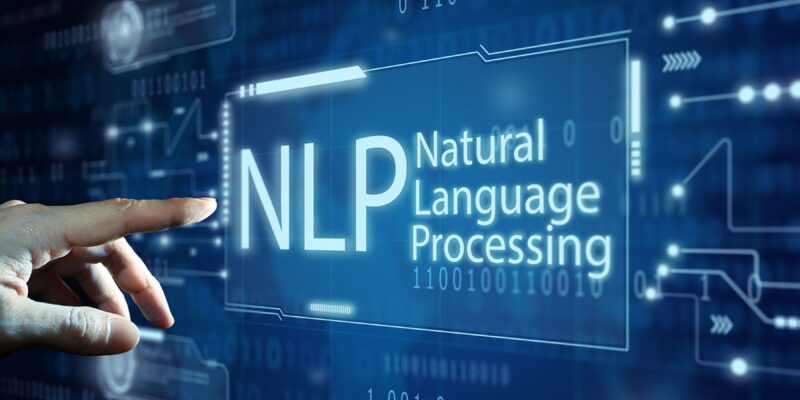| বাংলায় পড়ুন | Researchers and Reporters: Shama Sultana Ayesha Maria |
Ever wonder how Siri or Google Maps can answer your questions simply by hearing your voice? This technology is recognized as Natural Language Processing or NLP, and it plays a unique role in how people interact with technology.
NLP is a subfield of Artificial Intelligence or AI, and it is the process of giving computers the ability to speak like humans, such as understanding the words and text you speak and reacting accordingly.
NLP interprets text’s structure and meaning using rule-based machine learning techniques. It contributes to enterprise software, chatbots, voice assistants, text-based scanning apps, translation software, and other tools that simplify procedures and boost productivity for enterprises.
NLP has a plethora of linguistic expertise and has been in operation for more than 50 years. It can be used in a wide range of real-world contexts, including business, search engines, and medical research. Let’s examine a few examples to see how NLP is used in our everyday life.
The Invisible Power of NLP
Have you ever speculated how the Google search engine anticipates your writing before you start typing? Or how it continuously makes recommendations on social media the moment you type a word? Natural language processing, or NLP, is the unseen power behind all of this.
Magical search engine:
The Google search engine displays the most pertinent results according to your location, search purpose, and search history. It makes word suggestions depending on your typing style as you begin typing. If you write a mathematical calculation, it can even open a calculator!

The magic of a search engine powered by machine-driven technology. | Photo collected.
Smart search and predictive text:
The autocorrect, autocomplete, and predictive text features on your smartphone keyboard are also powered by NLP. They pick up on your typing habits and can even fix errors and recommend new terms. They set up their features as they get to know your usage habits.
The proficiency of NLP in language translation:
NLP’s most well-known application is in language translation. In the 1950s, an NLP-based machine that could translate between Russian and English was developed. Text and voice translation in nearly any language is possible with today’s translation apps via NLP and machine learning.
The Magic of NLP in Survey Analysis
In analyzing survey data, data analysis has advanced significantly. However, comprehension of unstructured content and the capacity to respond to open-ended inquiries are still in their infancy. Supported by other AI fields, NLP is striving to enable these sophisticated forms of analysis.
NLP enables you to efficiently and precisely examine your survey responses without the need for human intervention. Other code-based libraries that make it easier to extract information from the source text include SpaCy and Gensim.
The Semantic Search
Using semantic search to enhance the client experience is an example of how NLP is used in customer service. One search technique that may respond to a wide range of queries, comprehend their context, and present relevant results constitutes a semantic search.
When searching for a certain product description on an e-commerce website, for instance, the semantic search engine will comprehend your intent and present you with additional products that match your search query.
Many e-commerce sites and online merchants employ semantic search engines driven by natural language processing. By using long-tail keywords (e.g., women’s straight-leg denim size 4), they hope to better grasp the buyer’s intents and raise product visibility.
Sentiment Analysis
Sentiment analysis is frequently used by businesses to better understand the needs of their customers. An NLP approach called sentiment analysis sometimes referred to as opinion analysis, may identify if the data’s meaning is neutral, negative, or positive.

Sentiment analysis powered by machine learning technology. | Photo collected.
An email written by a disgruntled customer that contains the terms “defect” and “not worth the price,” for instance, will be instantly classified as negative Sentiment.
Chatbots:
Chatbots facilitate speedy completion of tasks including order tracking, bookings, and frequently asked questions. This enhances customer service and lowers expenses for small businesses.
Voice-based assistants like Siri and Alexa employ natural language processing (NLP) to learn about their users’ behaviors. This allows lists to be managed or shopping done with a voice command alone.
Smart Assistant:
Siri and Alexa are examples of voice-based assistants that employ natural language processing (NLP) to learn about their users’ behaviors. This allows you to shop or manage lists using a voice command alone.
Social Media Monitoring:
Trends and patterns of brands are found by analyzing comments on social media posts using natural language processing (NLP). Monitoring can provide insight into the brand’s future strategies and boost productivity by reducing working hours.
Optical Character Recognition (OCR):
The technology known as optical character recognition, or OCR, transforms printed or handwritten text into digital form. It can assist in the analysis or translation of the text. NLP-written documents are easily able to be edited and improved upon once they are saved on a digital device.
How does NLP work?
NLP generally works in two main steps:

NLP generally works in two main steps: data processing and language analysis, powered by machine technology. | Photo collected.
Data pre-processing: The process of making text or data machine-understandable.
Tokenization: Dividing sentences into words or small pieces.
Stop word removal: Removing less important words (such as “and,” “or”) and keeping the important parts.
Lemmatization and stemming: Bringing words back to their original form, such as “running” → “run.”
Part-of-speech tagging: Identifying verbs, adjectives, etc.
Logarithm development: Rule-based algorithms: Work according to predefined rules.
Machine learning algorithms: Determine methods by learning from large datasets.
The difficulties with NLP
Ambiguity and Context: Knowing local dialects, context, and human language fluency is not always simple.
Simplified Rules: As language evolves, pre-established rules become outdated.
Bias: If there is bias in the training dataset, the findings might not be reliable.
The artificial intelligence field of natural language processing (NLP) has facilitated human-machine interaction. Voice assistants, chatbots, and search engines are just a few of its many uses that have transformed daily life and business. Improved data and models will make it even more significant and effective in the future, despite the difficulties.

























Comments